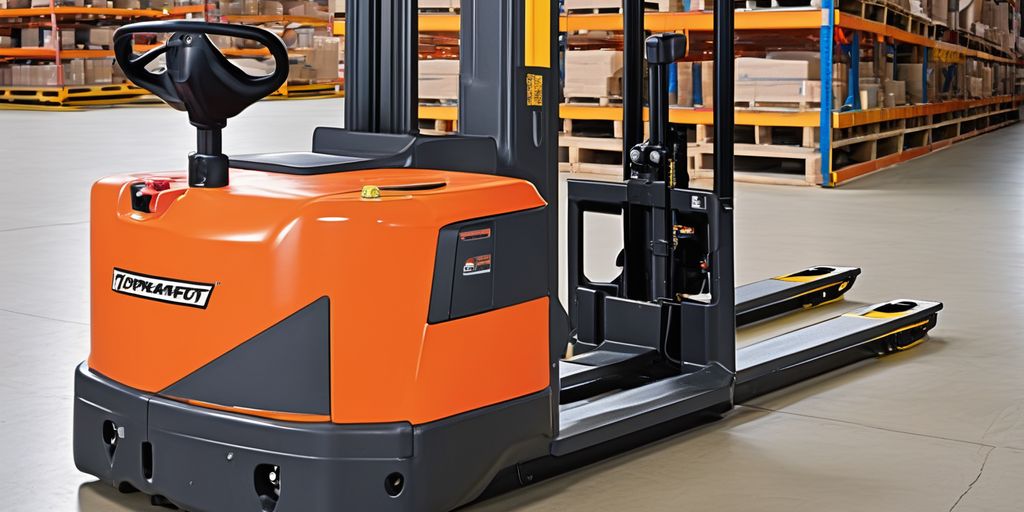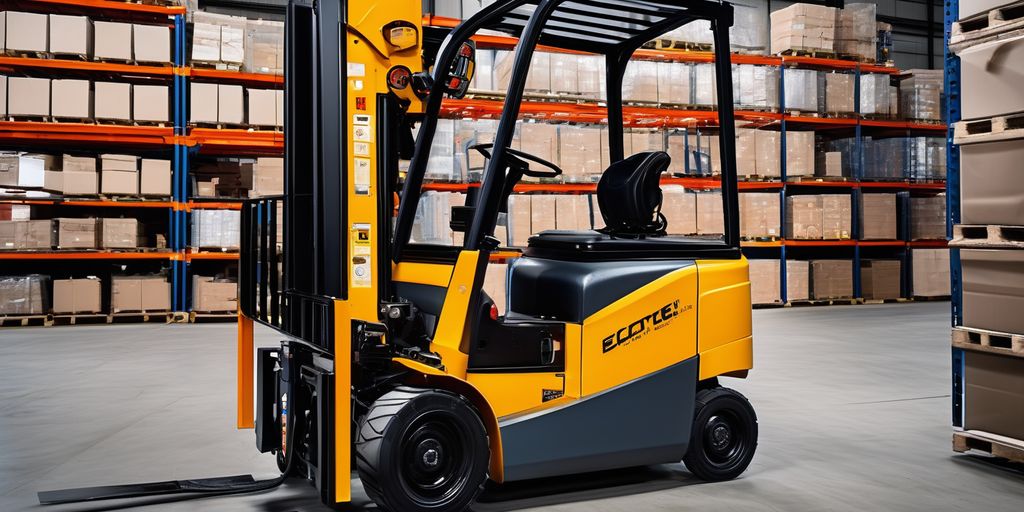Training your staff to operate forklifts safely and efficiently is crucial for maintaining a productive and accident-free workplace. This guide will walk you through the key areas to focus on when developing a comprehensive training program for forklift operators.
Key Takeaways
- Create a detailed training curriculum that covers operational techniques, safety procedures, and maintenance checks.
- Prioritize pedestrian safety by implementing effective communication, dedicated walkways, and alertness training.
- Encourage safe driving practices by respecting speed limits, being cautious during maneuvers, and maintaining safe distances.
- Ensure proper load management by understanding load capacities, preventing tip-overs, and adhering to lifting heights.
- Select qualified trainers with experience and provide them with train-the-trainer courses and regular evaluations.
Developing a Comprehensive Training Curriculum
Creating a thorough training curriculum is essential for ensuring that forklift operators are well-prepared for their roles. This curriculum should include both classroom instruction and hands-on practice to cover all necessary aspects of forklift operation.
Operational Techniques
Operators need to learn how to handle different types of forklifts and perform specific maneuvers. This includes tasks like stacking at heights and operating in tight spaces. Hands-on practice is crucial for mastering these skills.
Safety Procedures
Safety is paramount in forklift operation. The curriculum should cover OSHA Standard 1910.178, which includes pre-operation inspections, proper load handling, and navigating pedestrian traffic. This helps in reducing accidents and ensuring compliance with regulations.
Maintenance Checks
Regular maintenance checks are vital for keeping forklifts in good working condition. Operators should be trained to perform routine checks on hydraulic systems, tire conditions, and battery maintenance. This ensures that the machinery operates efficiently and safely.
Prioritizing Pedestrian Safety
Ensuring pedestrian safety in workplaces with forklifts is crucial. Effective communication between forklift operators and pedestrians can prevent many accidents. Operators should use horns or other audible warnings when approaching intersections or blind spots.
Effective Communication
Operators should use horns or other audible warnings when approaching intersections or blind spots. This helps alert pedestrians and other operators of the forklift's presence, reducing the risk of collisions.
Dedicated Walkways and Barriers
Creating dedicated walkways and barriers for pedestrians is essential. This minimizes the chances of pedestrians wandering into forklift operating zones. Use guard rails and floor markings to clearly define these areas.
Alertness Training
Training employees to stay alert around forklifts is vital. They should be aware of their surroundings and maintain a safe distance from operating forklifts. This includes understanding the importance of visual cues like flashing lights and backup alarms.
Implementing Safe Driving Practices

Respecting Speed Limits
Forklift operators must always respect speed limits to ensure safety. Driving too fast can lead to tip-overs and collisions with pedestrians or obstacles. Operators should slow down when turning or driving on wet or slippery surfaces. Always maintain a speed that allows you to stop safely.
Caution During Maneuvers
When making sharp turns, sudden stops, or reversing, exercise caution. These actions can cause tip-overs or collisions if not done carefully. Always stop completely before changing directions and use a horn or warning light to alert pedestrians.
Maintaining Safe Distances
Keeping a safe distance from other forklifts and obstacles is crucial. This helps prevent accidents and ensures clear visibility. Operators should always look in the direction of travel and use mirrors or spotters to increase visibility when needed.
Safe driving practices are essential for a secure and efficient workplace. By following these guidelines, operators can help prevent accidents and maintain a safe environment for everyone.
Ensuring Proper Load Management

Proper load management is crucial for safe forklift operation. Operators must understand the importance of load capacities to avoid accidents and ensure stability. By following best practices, they can prevent tip-overs and falling objects, which are common hazards in warehouses.
Selecting Qualified Trainers
Choosing the right trainers for forklift operations is crucial for ensuring safety and efficiency. Hiring experienced trainers with a solid background in material handling and workplace safety is essential. Ideally, trainers should have at least five years of direct operational experience with various types of forklifts, such as sit-down riders, stand-up counterbalances, and reach trucks. They should also have a proven track record in training roles or leadership positions in warehouse operations or similar environments.
Hiring Experienced Trainers
Trainers must be skilled in conveying complex information in an understandable manner. They should be capable of performing and teaching both basic and advanced forklift maneuvers, such as precision loading and unloading, maneuvering in tight spaces, and executing safe shut-down procedures. Their expertise should extend to understanding load dynamics, including weight distribution principles that impact forklift stability and safe load limits.
Train-the-Trainer Courses
For companies opting to train internal staff to become trainers, comprehensive train-the-trainer courses are essential. These courses should cover:
- Instructional Techniques: Effective communication methods, adult learning principles, and engagement strategies to ensure knowledge transfer is successful.
- OSHA Standards Mastery: In-depth knowledge of OSHA Standard 1910.178, which governs the safety requirements for the operation of forklifts and other powered industrial trucks.
- Operational Proficiency: Advanced operational techniques, including the specifics of electronic controls, hydraulic systems, and preventive maintenance routines.
Trainer Evaluation
It’s critical that both hired and internally trained trainers are validated for their expertise and effectiveness. This validation can include certifications from recognized industry bodies, such as the National Institute for Occupational Safety and Health (NIOSH) or specific forklift manufacturer training programs. Trainers should also undergo periodic evaluations to ensure their skills and knowledge remain current with industry standards and technological advancements in forklift design and safety features.
Ensuring trainers meet rigorous standards helps foster a robust safety culture, decrease workplace accidents, and increase overall operational efficiency.
Conducting Pre-Shift Inspections

Pre-shift inspections are essential to ensure forklifts are safe and ready for use. These checks help identify any issues that could lead to accidents or equipment failure during operation. Operators should ensure that all parts are in good working condition before starting the forklift.
Promoting Continuous Development
Ongoing Education
Encourage a culture of continuous learning within your organization by providing regular opportunities for further education and skills development. This could involve setting up subscription-based access to online training modules that cover advanced operational techniques or the latest safety protocols.
Additionally, offer workshops or seminars that focus on new technologies in forklift design, such as automated guidance systems or electric power conversions. Implement a rewards system to motivate employees to participate actively in these training opportunities, measuring their progress through quizzes or practical tests and acknowledging their advancements publicly to reinforce the importance of continuous learning.
Behavior-Based Safety
Promote a safety-first approach in every aspect of your operations, not just during scheduled training sessions. This means conducting regular safety meetings where teams can discuss recent incidents or near-misses and identify improvements in protocols. Encourage an open dialogue where employees feel comfortable reporting potential hazards without fear of repercussions.
Conclusion
Training your staff for safe and efficient forklift operation is crucial for maintaining a secure and productive workplace. By focusing on key areas such as load management, pedestrian safety, and safe driving practices, you can significantly reduce the risk of accidents. Developing a comprehensive curriculum, setting clear training goals, and choosing qualified trainers are essential steps in this process. Remember, continuous education and fostering a culture of safety are vital for long-term success. By investing in proper training and ongoing development, you ensure that your team is well-prepared to handle the challenges of forklift operation safely and efficiently.
Frequently Asked Questions
What are the key components of a forklift training curriculum?
A good forklift training curriculum covers operational techniques, safety procedures, and maintenance checks. It should also include hands-on training and emergency response protocols.
How can we ensure pedestrian safety in a workplace with forklifts?
To ensure pedestrian safety, use effective communication, create dedicated walkways and barriers, and train staff to stay alert. Using horns or warning devices can also help alert pedestrians.
What are some safe driving practices for forklift operators?
Forklift operators should respect speed limits, exercise caution during maneuvers, and maintain safe distances from other vehicles and obstacles to prevent accidents.
Why is load management important for forklift operators?
Proper load management prevents tip-overs and falling objects. Operators should understand load capacities, ensure even distribution, and adhere to recommended lifting heights.
What qualifications should a forklift trainer have?
A forklift trainer should have extensive experience with different types of forklifts, a strong safety background, and the ability to teach both basic and advanced maneuvers. Train-the-trainer courses are also beneficial.
How often should pre-shift inspections be conducted?
Pre-shift inspections should be conducted before every shift. These inspections include visual and operational checks to ensure the forklift is in good working condition.




Leave a comment
This site is protected by hCaptcha and the hCaptcha Privacy Policy and Terms of Service apply.